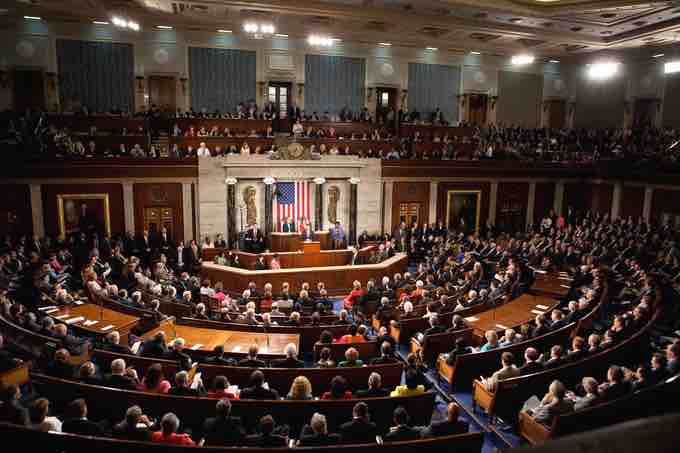The House of Representatives
Background
The United States House of Representatives is one of the two houses of the United States Congress (bicameral legislature). It is frequently referred to as the House. The other house is the Senate.

US Congress in Present Times
Using Weber's theory of stratification, members of the U.S. Congress are at the top of the social hierarchy because they have high power and status, despite having relatively little wealth on average.
The composition and powers of the House are established in Article 1 of the United States Constitution. The major power of the House is to pass federal legislation that affects the entire country although its bills must also be passed by the Senate and further agreed to by the United States President before becoming law (unless both the House and Senate re-pass the legislation with a two-thirds majority in each chamber). The House has several exclusive powers: the power to initiate revenue bills, to impeach officials, and to elect the President in case there is no majority in the Electoral College.
Each U.S. state is represented in the House in proportion to its population but is entitled to at least one representative. The most populous state, California, currently has 53 representatives. Law fixes the total number of voting representatives at 435. Each representative serves for a two-year term. The Speaker of the United States House of Representatives, who presides over the chamber, is elected by the members of the House, and is therefore traditionally the leader of the House Democratic Caucus or the House Republican Conference, whichever of the two Congressional Membership Organizations has more (voting) members.
Apportionment
The population of U.S. Representatives is allocated to each of the 50 states and DC, ranked by population. DC (ranked 50) receives no seats in the House. Under Article I, Section 2 of the Constitution, population, as determined by the census conducted every ten years, apportions seats in the House of Representatives among the states. Each state, however, is entitled to at least one Representative.
Qualifications
Article I, Section 2 of the Constitution sets three qualifications for representatives. Each representative must: (1) be at least twenty-five years old; (2) have been a citizen of the United States for the past seven years; and (3) be (at the time of the election) an inhabitant of the state they represent. Members are not required to live in the district they represent, but they traditionally do. The age and citizenship qualifications for representatives are less than those for senators. The constitutional requirements of Article I, Section 2 for election to Congress is the maximum requirements that can be imposed on a candidate. Therefore, Article I, Section 5, which permits each House to be the judge of the qualifications of its own members does not permit either House to establish additional qualifications. Likewise, a state could not establish additional qualifications.
Demographics
Congress is constantly changing, constantly in flux. In recent times, the American south and west have gained House seats according to demographic changes recorded by the census and includes more minorities and women although both groups are still underrepresented, according to one view. While power balances among the different parts of government continue to change, the internal structure of Congress is important to understand along with its interactions with so-called intermediary institutions such as political parties, civic associations, interest groups, and the mass media.
Elections
Elections for representatives are held in every even-numbered year, on Election Day the first Tuesday after the first Monday in November. Representatives must be elected from single-member districts by plurality voting.
In most states, major party candidates for each district are nominated in partisan primary elections, typically held in spring to late summer. In some states, the Republican and Democratic parties choose their respective candidates for each district in their political conventions in spring or early summer. They often use unanimous voice votes to reflect either confidence in the incumbent or as the result of bargaining in earlier private discussions.
Representatives and Delegates serve two-year terms, while the Resident Commissioner serves for four years. The Constitution permits the House to expel a member with a two-thirds vote. In the history of the United States, only five members have been expelled from the House.